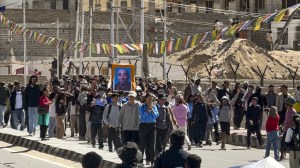Terror by any other colour
In the context of violence-ridden Nepal, it seemed to be no big deal. Indra Bahadur Bhujel, a retired policeman, was abducted by Maoists la...

In the context of violence-ridden Nepal, it seemed to be no big deal. Indra Bahadur Bhujel, a retired policeman, was abducted by Maoists last month. The events that followed have added a new player to the deadly power game being played out there.
Some 300 villagers gathered to look for Bhujel the following day. They found him bound and gagged in a goat pen in an adjoining village. Two sentries stood guard. The mob first freed Bhujel and then, in the presence of the Army, beat the Maoist sentries to death.
Within hours, rampaging mobs had killed nine people in the name of hitting back at the Maoists whose battles with the security personnel have claimed 11,000 lives over nine years.
This happened on February 17. On February 18, adjoining villages, terrorised by the Maoists for years, came out to join what is now being called a ‘‘Maoists resistance movement’’.
In truth, lynch mobs are taking over sections of Nepal. Some 26 people accused of being Maoists have been killed, said Nepalese Army spokesman, General Deepak Gurung. No evidence is required in this street justice and many innocents may have died in the purge. The Maoists have hit back by killing 13 members of the resistance movement.
Caught in the crossfire of this battle between the Maoists and the new groups, many locals are planning to flee across the border and authorities say that almost 30,000 may already have crossed over into India.
The resistance groups have become a law unto themselves. Last week, this reporter saw a group of 32 men gathered in Ganeshpur. Each was armed with a bamboo staff that served as a weapon. ‘‘Kill the Maoists and their supporters,’’ a young man shouted. He was serious.
In Bishanpura village, some 140 straw huts have been burnt down after their occupants were accused of being Maoist sympathisers.
In Hallarpur, more than 300 huts were gutted.
A police officer admits that ‘‘unruly elements’’ have taken over the movement, but it still suits the government to lionise those fighting the Maoists. Home Minister Dan Bahadur Shahi and Education Minister Radhakrishna Mainali have both addressed and supported the villages that are acting against the Maoists. This has strengthened the resistance movement but also made things more difficult for those caught in the middle.
Himanchal Pasi, the mother of 40-year-old Rambali Pasi, recalls how her son was dragged out of his home, beaten and burnt to death. Two other men from Barahipur suffered the same fate. A year ago, a village functionary had been killed by Maoists and these were then seen as revenge killings by the resistance movement.
The chief district officer Modraj Dotel says that at its peak the movement saw some 25,000 people actively hunting down the Maoists. The movement has spread to 21 other villages in a 50-km radius of Ganeshpur.
Its leaders now issue Maoist-type diktats. Some people have been told to join the movement or face a fine of 5,000 Nepalese rupees. Three resistance movement members tried to rape an 11-year-old girl.
To complete the misery for the villagers, the Maoists, who remain strong as ever, beheaded some members of this movement.
The villagers have nowhere to run, except India. Kala Hussein Siddiqui, a 30-year-old from Labani, has fled from Labani to the Indian town of Kakrahawa. ‘‘Even if you pay me Rs 50,000, I won’t return,’’ he swears.
(With additional reporting by Balkrishna Chapagain, Hemant Karmacharya and Line Wolf Nielsen)





- 01
- 02
- 03
- 04
- 05


























